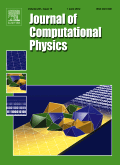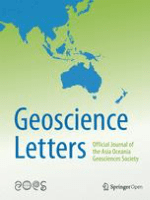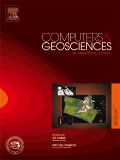
COMPUTATIONAL GEOSCIENCES
Scope & Guideline
Advancing Earth Science through Computational Innovation
Introduction
Aims and Scopes
- Development of Computational Models:
The journal emphasizes the creation and refinement of computational models that simulate geological processes, including fluid dynamics in porous media, seismic wave propagation, and geomechanical behavior. - Application of Advanced Algorithms:
It features research involving innovative algorithms such as finite element methods, machine learning, and optimization techniques to enhance the accuracy and efficiency of geoscientific simulations. - Data Integration and Analysis Techniques:
The journal addresses the integration of diverse geoscientific data sources, including geophysical, geological, and hydrological data, to improve model predictions and facilitate decision-making. - Focus on Environmental and Resource Management:
Research that contributes to the sustainable management of natural resources, such as groundwater, oil, and gas, as well as the assessment of environmental impacts related to geological activities, is a core area of the journal. - Interdisciplinary Approaches:
The journal encourages interdisciplinary research that combines principles from mathematics, physics, and earth sciences to tackle complex geoscientific challenges.
Trending and Emerging
- Integration of Machine Learning:
There is a significant increase in the application of machine learning techniques across various geoscientific fields, including reservoir characterization, fluid flow prediction, and seismic data analysis. This trend highlights the growing recognition of machine learning as a powerful tool for enhancing model accuracy and efficiency. - Data Assimilation and Uncertainty Quantification:
Research focusing on data assimilation techniques and uncertainty quantification is gaining prominence. This reflects a broader trend towards improving model reliability and robustness in the face of inherent uncertainties in geoscientific data. - Advanced Multiscale Modeling:
The shift towards multiscale modeling approaches that can capture complex geological phenomena at different spatial and temporal scales is becoming increasingly prevalent. This trend underscores the need for integrated models that address the intricacies of subsurface systems. - Environmental Sustainability and Resource Management:
Papers addressing sustainable practices in resource extraction, environmental protection, and climate change impacts are on the rise. This shift indicates a growing emphasis on the role of computational geosciences in supporting sustainable development goals. - Physics-Informed Neural Networks:
The emergence of physics-informed neural networks (PINNs) as a methodology for integrating physical laws into machine learning models is gaining traction. This trend reflects the ongoing effort to merge traditional geoscientific principles with modern computational techniques.
Declining or Waning
- Traditional Numerical Methods:
There is a noticeable decline in the publication of papers focusing solely on traditional numerical methods without integration with newer technologies or methodologies. The shift towards incorporating machine learning and advanced data-driven approaches indicates a waning interest in conventional techniques. - Hydrological Modeling without Machine Learning:
Research specific to hydrological modeling that does not utilize machine learning or data assimilation techniques is becoming less frequent. The increasing complexity of hydrological systems has led to a preference for approaches that leverage data-driven insights. - Simplistic Geological Modeling Techniques:
Papers that focus on basic geological modeling without considering the impacts of uncertainty, variability, or advanced computational techniques are less common. The trend indicates a move towards more sophisticated, multifaceted modeling approaches.
Similar Journals

JOURNAL OF COMPUTATIONAL PHYSICS
Elevating Standards in Interdisciplinary Physics ResearchJOURNAL OF COMPUTATIONAL PHYSICS, an esteemed publication from ACADEMIC PRESS INC ELSEVIER SCIENCE, serves as a premier platform in the field of computational physics and its interdisciplinary applications. Since its inception in 1966, the journal has provided invaluable insights and significant advancements in areas such as applied mathematics, numerical analysis, and modeling and simulation. With a robust impact factor and ranking in the top quartile across various related categories, including Q1 in Applied Mathematics and Physics and Astronomy, it is essential reading for researchers and professionals aiming to stay at the forefront of computational techniques and methodologies. Although the journal is not open access, it remains highly regarded with a reputation for rigorous peer review and high-quality publications. As the field continues to evolve, the JOURNAL OF COMPUTATIONAL PHYSICS highlights innovative research that not only advances theoretical constructs but also offers practical applications in scientific and engineering domains. For scholars and students, this journal embodies a critical resource for deepening their understanding and fostering dialogue within the scientific community.

Geoscience Letters
Exploring the Depths of Earth and BeyondGeoscience Letters, published by Springer, is a prominent open-access journal in the field of Earth and Planetary Sciences, recognized for its dedication to advancing knowledge and research in this vital area of study. With a reported impact factor that reflects its esteemed position—ranking in the Q1 quartile of Earth and Planetary Sciences, particularly as the journal ranks #48 out of 195 in the general category according to Scopus—the journal serves as a vital resource for researchers, professionals, and students. Since its inception in 2014, Geoscience Letters has facilitated the dissemination of high-quality research and critical insights, aiming to bridge the gap between scientific discovery and societal needs. Its commitment to open access ensures that the latest findings are readily available to a global audience, thus enhancing collaboration and innovation within the geosciences community.

Computation
Fostering innovation in computational research.Computation, published by MDPI, is an esteemed open-access journal that has been contributing to the fields of applied mathematics and computer science since its inception in 2013. With an E-ISSN of 2079-3197, this Swiss-based journal operates under a philosophy of free knowledge dissemination, allowing researchers, professionals, and students globally to access high-quality content without financial barriers. Recognized for its rigorous peer-review process, Computation is currently categorized in the Q2 and Q3 quartiles across significant domains, including Applied Mathematics (#181/635), Theoretical Computer Science (#52/130), and Modeling and Simulation (#138/324). As it converges towards 2024, the journal continues to attract innovative and impactful research aimed at advancing theoretical frameworks and practical applications within these disciplines. Joining the Computation community not only enriches individual research portfolios but also contributes to the broader conversation on computational methodologies and their applications in solving real-world problems.

Computational and Mathematical Methods
Empowering Discoveries in Computational and Mathematical SciencesComputational and Mathematical Methods is a dynamic peer-reviewed journal published by Wiley-Hindawi, focusing on innovative research in the fields of computational mathematics, mechanics, and theory. Since its transition to an Open Access format in 2022, the journal has enhanced its accessibility to researchers and practitioners globally, providing a platform for the dissemination of high-quality studies that contribute to emerging developments in mathematical modeling and computational techniques. Based in the United Kingdom, this journal is committed to fostering collaboration amongst scholars, evidenced by its rankings within Scopus: Q3 in computational mathematics, computational mechanics, and computational theory and mathematics, reflecting its relevance and influence within these critical fields. With an emphasis on interdisciplinary studies, Computational and Mathematical Methods is an essential resource for researchers, professionals, and students seeking to expand their knowledge and apply cutting-edge methodologies to practical challenges.

International Journal of Computing Science and Mathematics
Unveiling New Dimensions in Applied Mathematics and ComputationThe International Journal of Computing Science and Mathematics, published by INDERSCIENCE ENTERPRISES LTD, is a pivotal platform for the dissemination of cutting-edge research in the intertwined disciplines of computing science and mathematics. With an ISSN of 1752-5055 and an E-ISSN of 1752-5063, the journal primarily serves the academic community engaged in applied mathematics, computational mathematics, theoretical computer science, and more, making significant contributions that resonate across various fields of technology and science. While the journal is currently categorized in the Q4 quartile for multiple related fields, including Applied Mathematics and Computational Theory, it continues to strive towards advancing the knowledge and practice within these areas. Spanning years from 2007 to 2010 and again from 2012 to 2024, the journal seeks to publish high-quality, peer-reviewed articles that not only address theoretical advancements but also explore practical applications of computing science in mathematical contexts, thereby fostering collaboration among researchers, professionals, and students alike. Please note that this journal is not available as Open Access, thus ensuring a curated content selection intended for dedicated research communities.

Journal of Algorithms & Computational Technology
Connecting Scholars to the Future of Computational InnovationJournal of Algorithms & Computational Technology, published by SAGE PUBLICATIONS LTD, serves as a noteworthy platform for scholars and practitioners in the realms of applied mathematics, computational mathematics, and numerical analysis. With an ISSN of 1748-3018 and an E-ISSN of 1748-3026, this Open Access journal has been disseminating high-quality research since 2007, ensuring that significant advancements in algorithmic techniques and computational methodologies are readily accessible to the global academic community. Based in the United Kingdom, this journal has steadily established itself within specialized quartiles, notably achieving Q3 ranking in Computational Mathematics and Q4 in both Applied Mathematics and Numerical Analysis for 2023, reflecting its growing influence in these fields. As the journal converges from 2011 to 2024, it aims to cater to the needs of researchers, professionals, and students by publishing innovative research that not only addresses theoretical frameworks but also provides practical applications. By leveraging its open-access model, the Journal of Algorithms & Computational Technology fosters a collaborative environment where knowledge can flourish, allowing for the continuous evolution of algorithms that drive technological advancement.

COMPUTATIONAL MATHEMATICS AND MATHEMATICAL PHYSICS
Exploring Complex Problems with Precision and InsightCOMPUTATIONAL MATHEMATICS AND MATHEMATICAL PHYSICS is a prestigious journal published by PLEIADES PUBLISHING INC, dedicated to advancing the fields of computational mathematics and mathematical physics. With an ISSN of 0965-5425 and an E-ISSN of 1555-6662, the journal has established its importance within the academic community since its inception in 1985. It is classified in the third quartile (Q3) for computational mathematics in 2023, and while currently it does not offer open access options, it remains a valuable resource for researchers seeking to disseminate their findings and engage with cutting-edge developments in the field. The journal encompasses a broad spectrum of topics, including numerical analysis, applied mathematics, and the intersection of physics and computational techniques, highlighting its relevance in addressing complex problems in both theoretical and applied contexts. Scholars will find a platform that not only promotes rigorous research but also encourages collaboration and innovation within the scientific community.

COMPUTERS & GEOSCIENCES
Unveiling the Power of Computing in GeosciencesCOMPUTERS & GEOSCIENCES, published by PERGAMON-ELSEVIER SCIENCE LTD, is a prestigious academic journal that delivers cutting-edge research at the intersection of computational techniques and geosciences. With an ISSN of 0098-3004 and an E-ISSN of 1873-7803, this journal has been contributing significantly to the field since its inception in 1975 and continues to attract noteworthy articles through 2024. Recognized as a Q1 journal in both the categories of Computers in Earth Sciences and Information Systems, it ranks within the top 12% and 17% of its respective fields according to Scopus. The journal emphasizes innovative applications of computer science in geoscience, providing a platform for researchers to share their findings, methodologies, and advancements. Researchers, professionals, and students dedicated to exploring the computational facets of environmental studies will find this journal to be an invaluable resource.

Eurasian Journal of Mathematical and Computer Applications
Empowering Research in Applied Mathematics and Computer Science.Eurasian Journal of Mathematical and Computer Applications, published by the prestigious L N GUMILYOV EURASIAN NATIONAL UNIVERSITY in Kazakhstan, stands as a vital platform for researchers and professionals engaging in the fields of Applied Mathematics, Computational Mathematics, Computer Science Applications, Information Systems, Mathematical Physics, and Modeling and Simulation. With its ISSN 2306-6172 and E-ISSN 2308-9822, this academic journal aims to foster innovative research and facilitate knowledge transfer in these interdisciplinary domains. The journal, which converges its endeavors from 2013 to 2024, is currently ranked Q3 across its various categories in 2023, reflecting its growing influence and commitment to academic excellence. Despite its open access availability, the journal's dedication to quality research is evident as it attracts contributions that not only advance theoretical understanding but also address practical applications. With a supportive community of researchers in an increasingly important field, the Eurasian Journal of Mathematical and Computer Applications is poised to remain a significant resource for those seeking to propel the boundaries of mathematical and computational sciences.

JOURNAL OF COMPUTATIONAL AND APPLIED MATHEMATICS
Elevating Standards in Mathematical ResearchJOURNAL OF COMPUTATIONAL AND APPLIED MATHEMATICS, published by Elsevier, stands as a premier platform for researchers and practitioners in the fields of applied and computational mathematics. With an impressive convergence history from 1975 to 2025, this journal has established itself as a crucial reference point for innovative mathematical theories, methodologies, and applications. Holding a distinguished position in Scopus rankings—#85 out of 635 in Applied Mathematics and #36 out of 189 in Computational Mathematics—it operates in the highly competitive Q2 quartile for both disciplines as of 2023. Although currently not designated as an open-access journal, it remains widely respected for its rigorous peer-review process and high-quality research contributions. Researchers and professionals seeking to advance their work and engage with cutting-edge developments will find this journal an invaluable resource, fostering a deeper understanding and collaboration within the mathematical community.